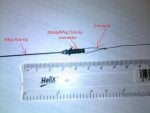A
Alan Cooper
Guest
Sounds like a good topic! Also a question to Alan Rowe (and anybody else) re his reply to Alan Rounder on Barbel reels. I've read that Richard Carter reels are brilliant although I've never seen one. Are they standard "hut" bearing reels rather than ball bearing? And I have another question: What is the freeest running reel for trotting? And what should be the test of free running? As to the latter, I would suggest that it is NOT how long the reel spins for - this is more to do with the mass of the reel, but rather how many shot and of what size it takes to freely start the reel spinning from rest (moment of inertia). I have a Shakespeare Lincoln that on this test will start spinning freely with one No4 and one No6 shot.My Youngs caged lightweight (brand new however) takes 5 No 4 shot before it starts to revolve. For me, this is the real test of a trotting centrepin - what about a Carter? And where can I see one? And what do others think?

